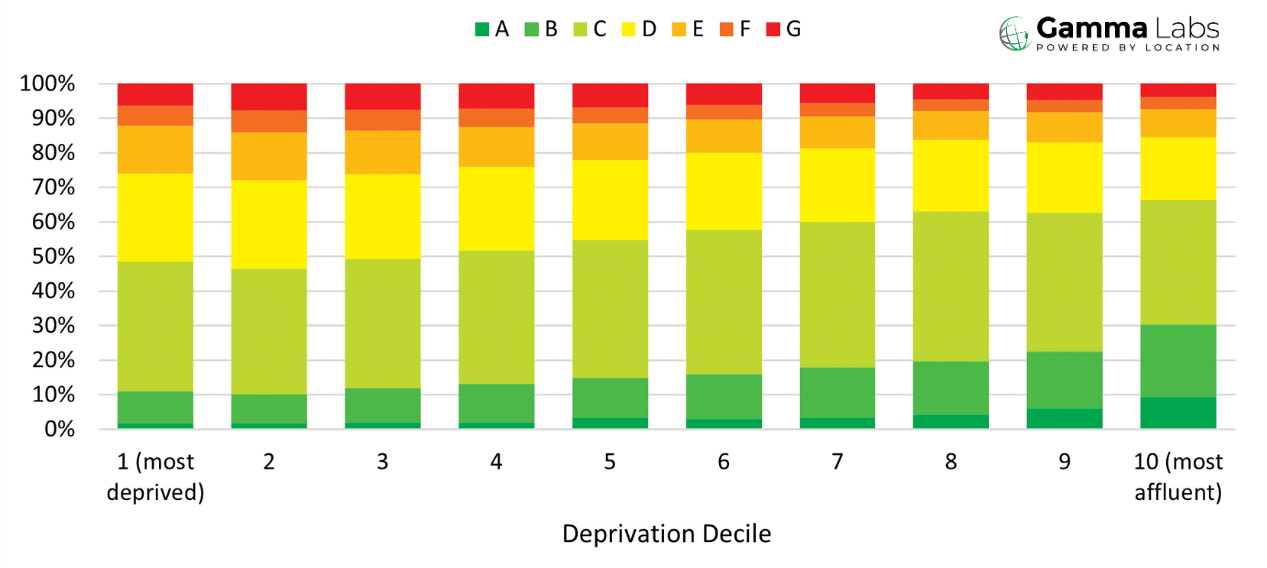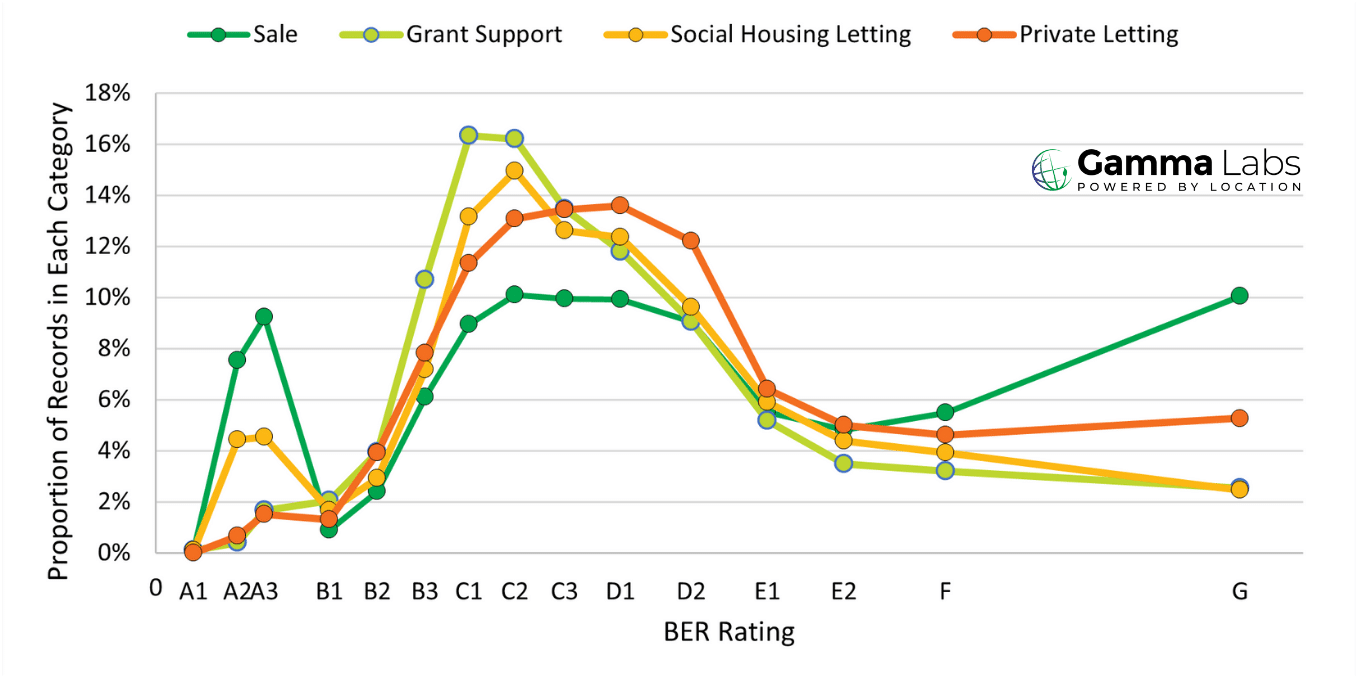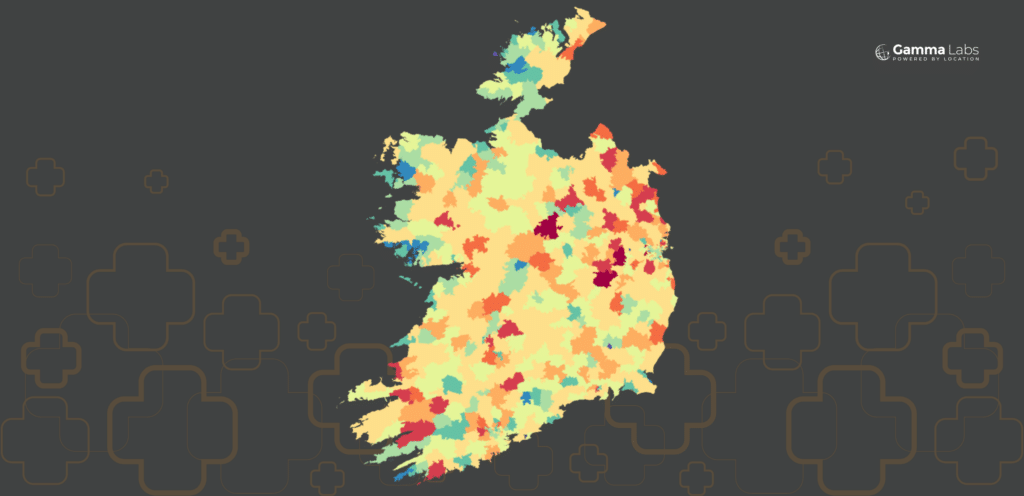Gamma Labs Research Reveals Trends in Energy Efficiency of Irish Homes
Key Takeaways
- A third (33%) of A-rated homes are located in the most affluent 10% of the country, while only 2% are found in the least affluent 10%.
- Six counties had more than double the amount of E/F/G-rated than A/B-rated homes.
- Private lettings revealed as Ireland’s least energy efficient housing.
- Only 42% of Ireland’s housing stock has a BER certification.
Gamma Labs, the leading location intelligence technology company in Ireland, has published a comprehensive new report that sheds light on energy efficiency trends within the nation’s housing stock.
Collaborating with BERWOW, a specialist in Building Energy Ratings (BER), the report analyses energy efficiency across various socioeconomic demographics, geographic locations, and property types.
The full report is available for download on the link below:
Key Findings and BER Insights
The report finds a correlation between BER ratings and the socioeconomic status of homeowners. Notably, one-third (33%) of A-rated homes are concentrated in the most affluent 10% of the country, while a mere 2% of homes in the least affluent areas achieve an A rating. Moreover, over a quarter (26%) of homes in these economically disadvantaged regions are rated E or below.
See the graph below:

In assessing energy efficiency across counties, the study identifies stark disparities. Only four counties – Cork, Kildare, Louth, and Meath – report an excess of A/B-rated homes compared to those rated E/F/G. Conversely, counties such as Clare, Leitrim, Mayo, Offaly, Roscommon, and Tipperary show a concerning trend, with more than double the number of E/F/G-rated homes compared to A/B-rated homes.
The findings also indicate that private lettings are the least energy efficient housing option in Ireland, with 86% of such properties receiving a C rating or lower; nearly half (47%) of these homes earned a D rating or worse. In contrast, newly constructed homes demonstrated higher energy efficiency, with 89% assigned an A rating and the remaining properties receiving a B rating. Overall, it is revealed that only 42% of the entire housing stock has been evaluated for a BER certification.
See the graph below:

Another noteworthy insight uncovered by the research was the uneven distribution of kilowatt-hours per square metre of floor area (kWh/m²), which determines a property’s BER. Peaks and troughs were observed in every band at the cutoff points between ratings and were more pronounced at cutoffs which would result in a letter change in a property’s rating.
For example, there were almost three times as many properties listed with an energy requirement of 299 kWh/m² than 301kWh/m², with 300kWh/m² being the cutoff between a C and D rating. There are a wide number of popular methods to drive even small incremental changes such as the installation of additional low energy lights or a new cylinder lagging jacket.
See the graph below:

This report is released in conjunction with Gamma’s strategic rebranding into two distinct entities. Gamma Labs aims to simplify complexity, support profitability and enable sustainability for organisations by leveraging property and neighbourhood data. Meanwhile, its Insurtech business, Gamma Risk, uses cutting edge technology and analysis to assess risk for insurance companies and related stakeholders.
As a step towards sustainability, Gamma Labs is also part of the EU’s OneClickRENO research project. This initiative aims to transition to zero-emission building standards by emphasizing the benefits of comprehensive renovations through Building Renovation Passports (BRPs).
The full report is available for download on the link below:
Commenting on these findings, Charlotte Cuffe, Chief Data Scientist at Gamma Labs, said: “Having access to such property insights is not just useful for homeowners in terms of assessing energy efficiency and retrofitting options (including grants), but also construction companies, energy providers, banks, estate agents and insurance companies. This data can provide a baseline or a benchmark from which people can look to improve their green credentials.”
Michael Hanratty, CEO of BERWOW, added: “Equipping stakeholders with data which can enhance their service offerings, lower investment risk, and empower sustainable decision-making is a crucial step in the sustainability journey. In turn, this means organisations can make operations greener, people can create more efficient homes, and Ireland as a whole can take crucial steps to get closer to our emissions targets.”
Note on Analysis
*This Gamma Labs analysis is based on Building Energy Rating (BER) data, made available in anonymised form by the Sustainable Energy Authority of Ireland (SEAI). It relates to only households/properties where BER ratings and certificates have been assessed. BER ratings are based on surveys by qualified assessors where a calculation is done around how much energy, in kWh per square metre per year, a household should use – according to heating periods defined by the SEAI. This is calculated irrespective of how the homeowner heats the dwelling, therefore the actual energy consumption of an individual household may be higher or lower than the BER indicates. Gamma Labs accepts no liability to any third party for any loss or damage arising from any interpretation or use of the information contained in this report, or reliance on any views expressed therein.
@ 2024 Gammalabs.ie



